Related Research Articles

Under the Whyte notation for the classification of steam locomotives, 4-8-4 represents the wheel arrangement of four leading wheels on two axles, eight powered and coupled driving wheels on four axles and four trailing wheels on two axles. The type was first used by the Northern Pacific Railway, and initially named the Northern Pacific, but railfans and railroad employees have shortened the name since its introduction. It is most-commonly known as a Northern.

The Prince Edward Island Railway (PEIR) was a historic Canadian railway in Prince Edward Island (PEI). The railway ran tip-to-tip on the island, from Tignish in the west to Elmira in the east, with major spurs serving Borden-Carleton's train ferry dock, the capital in Charlottetown, Montague and Georgetown and the original eastern terminus at Souris. A major spur from Charlottetown served Murray Harbour on the south coast.
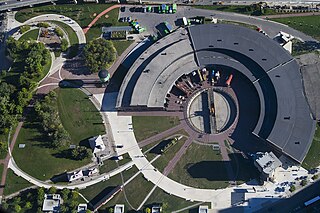
A railway roundhouse is a building with a circular or semicircular shape used by railways for servicing and storing locomotives. Traditionally, though not always the case today, these buildings contained or were adjacent to a turntable.
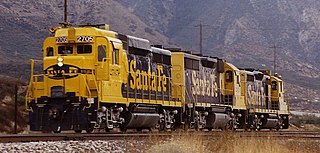
The EMD GP30 is a 2,250 hp (1,680 kW) four-axle diesel-electric locomotive built by General Motors Electro-Motive Division of La Grange, Illinois between July 1961 and November 1963. A total of 948 units were built for railroads in the United States and Canada, including 40 cabless B units for the Union Pacific Railroad.
The Champlain and St. Lawrence Railroad (C&SL) was a historic railway in Lower Canada, the first Canadian public railway and one of the first railways built in British North America.

The Elgin, Joliet and Eastern Railway was a Class II railroad, making a roughly circular path between Waukegan, Illinois and Gary, Indiana. The railroad served as a link between Class I railroads traveling to and from Chicago, although it operated almost entirely within the city's suburbs, only entering Chicago where it served the U.S. Steel South Works on the shores of Lake Michigan. Nicknames for the railroad included "The J", EJ&E and "The Chicago Outer Belt Line". At the end of 1970, the EJ&E operated 164 miles of track and carried 848 million ton-miles of revenue freight in that year alone.

The Royal Hudsons are a series of semi-streamlined 4-6-4 "Hudson" type steam locomotives formerly owned and operated by the Canadian Pacific Railway (CPR) and built by Montreal Locomotive Works (MLW). The engines were built in 1937. In 1939, King George VI allowed the CPR to use the term after Royal Hudson number 2850 transported the royal train across Canada with no need of replacement. These locomotives were in service between 1937 and 1960. Four of them have been preserved. No. 2839 was used to power excursions for the Southern Railway Steam Program between 1979 and 1980. No. 2860 was used for excursion service in British Columbia between 1974 and 1999, then again between 2006 and 2010.
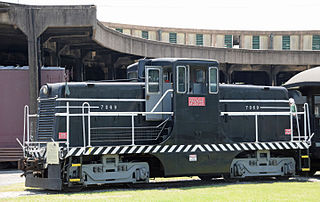
The GE 44-ton switcher is a four-axle diesel-electric locomotive built by General Electric between 1940 and 1956. It was designed for industrial and light switching duties, often replacing steam locomotives that had previously been assigned these chores.

The Strasburg Rail Road is a heritage railroad and the oldest continuously operating standard-gauge railroad in the western hemisphere, as well as the oldest public utility in the Commonwealth of Pennsylvania. Chartered in 1832, the Strasburg Rail Road Company is today a heritage railroad offering excursion trains hauled by steam locomotives on 4.02 mi (6.47 km) of track in Pennsylvania Dutch Country, as well as providing contract railroad mechanical services, and freight service to area shippers. The railroad's headquarters are outside Strasburg, Pennsylvania.

Alberta Prairie Railway Excursions is a heritage railway originating in Stettler, Alberta.

The ALCO S-2 and S-4 are 1,000-horsepower (746 kW) diesel electric switcher locomotives produced by ALCO and Canadian licensee Montreal Locomotive Works (MLW).

The ALCO FA is a family of B-B diesel locomotives designed to haul freight trains. The locomotives were built by a partnership of ALCO and General Electric in Schenectady, New York, between January 1946 and May 1959. Designed by General Electric's Ray Patten, they were of a cab unit design; both cab-equipped lead FA and cabless booster FB models were built. A dual passenger-freight version, the FPA/FPB, was also offered. It was equipped with a steam generator for heating passenger cars.
The MLW RSC-14 was a diesel-electric locomotive rebuilt by Canadian National Railway from locomotives originally supplied by Montreal Locomotive Works.

The Via Rail FP9ARM was a re-manufactured version of a GMD FP9A diesel passenger locomotive, rebuilt between 1983 and 1985 by Canadian National Railways at their Pointe St-Charles shops.
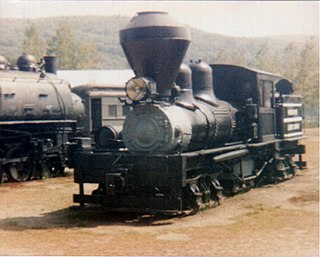
Steamtown, U.S.A., was a steam locomotive museum that ran steam excursions out of North Walpole, New Hampshire, and Bellows Falls, Vermont, from the 1960s to 1983. The museum was founded by millionaire seafood industrialist F. Nelson Blount. The non-profit Steamtown Foundation took over operations following his death in 1967. Because of Vermont's air quality regulations restricting steam excursions, declining visitor attendance, and disputes over the use of track, some pieces of the collection were relocated to Scranton, Pennsylvania in the mid-1980s and the rest were auctioned off. After the move, Steamtown continued to operate in Scranton but failed to attract the expected 200,000–400,000 visitors. Within two years the tourist attraction was facing bankruptcy, and more pieces of the collection were sold to pay off debt.
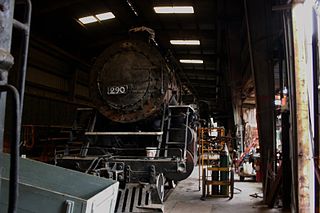
Atlanta and West Point 290 is a P-74 steam locomotive built in March 1926 by the Lima Locomotive Works (LLW) in Lima, Ohio for the Atlanta and West Point Railroad. It is a 4-6-2 heavy "Pacific" type steam locomotive, which was remarkably similar to the Southern Railway's Ps-4 class. With sister locomotive No. 190 built for the Western Railway of Alabama (WRA), No. 290 ferried the Southern Railway's Crescent passenger train on the West Point Route between Atlanta, Georgia to Montgomery, Alabama until its retirement from revenue service in 1954.
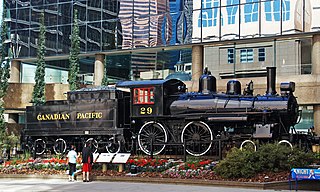
Canadian Pacific Railway No. 29 is a preserved Canadian A-1e class 4-4-0 steam locomotive. It was built by the Canadian Pacific's DeLorimier Shops in 1887 as locomotive No. 390, before being renumbered 277 in 1905. It was renumbered again to 29 after being rebuilt in 1912. By the 1950s, No. 29 was the youngest of three CPR 4-4-0s that were regularly used on the Norton-Chipman mixed train. After being retired from the Canadian Pacific in 1960, the locomotive was donated to the Canadian Railway Museum in Saint-Constant, Quebec for static display. In 1983, No. 29 was acquired by the Salem and Hillsborough Railway, and it was then moved to Hillsborough, New Brunswick, for further display. It was subsequently restored to operating condition for the locomotive's 100th birthday in 1987. In late 1994, No. 29 fell victim to a shed fire that would put an end to the locomotive's S&H career. Two years later, the locomotive was reacquired by the Canadian Pacific, who moved and cosmetically restored it for static display in front of their headquarters in Calgary, Alberta. In 2017, the locomotive was moved again to the CPR's new headquarters in Ogden yard. Although the locomotive is in good condition, an operational restoration on No. 29 would be expensive.
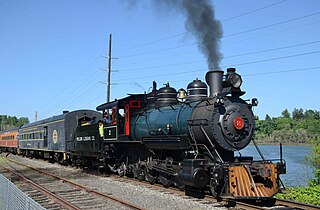
Polson Logging Company 2 is a 2-8-2 “Mikado” steam locomotive built by the Baldwin Locomotive Works. It was originally built for the Saginaw Timber Company to pull logging trains. After that, it went through several ownership changes throughout both the steam era and the preservation era, before it was purchased by caretaker Skip Lichter in 1982. Lichter restored Polson Lumber 2 to operational condition and loaned it to the Mid-Continent Railway Museum in North Freedom, Wisconsin. The engine was later removed from service in 2000 to undergo a federally-mandated rebuild. Disagreement over who should cover the restoration costs ultimately led to an arbiter finding in Lichter's favor.

Canadian National 1009 is a preserved Canadian 4-6-0 "ten-wheeler" steam locomotive built by the Montreal Locomotive Works in 1912. It was originally built with 1880's specifications as part of a standard locomotive design to help construct a Canadian National Transcontinental Railway. The locomotive would subsequently serve the Canadian Government Railways, which was later absorbed into the Canadian National Railway. No. 1009's last revenue run took place in the spring of 1958, and it was subsequently donated to the Canadian Railway Museum for static display. Later on, it was purchased by the Salem and Hillsborough Railway with the intention to use it to pull their tourist trains. As of 2025, No. 1009 remains on indoor static display.

Canadian National 6218 is a 4-8-4 U-2-g Confederation built by the Montreal Locomotive Works (MLW) in 1942 for the Canadian National Railway. It became famous after it was brought back by CN for their Steam Excursion Program from 1964 to 1971. It is now on static display at the Fort Erie Railway Museum in Fort Erie, Ontario.
References
- ↑ "Hillsborough rail museum turns cars over to paint ball business". CBC. 2015-07-17. Retrieved 2022-05-26.
- ↑ Eiselt, H. A.; Eiselt, Marianne (2002-04-19). Discovering New Brunswick. Formac Publishing Company. pp. 43–44. ISBN 978-0-88780-556-1.
- ↑ Pitt, John (2008). USA by Rail. Bradt Travel Guides. p. 298. ISBN 978-1-84162-255-2.
- ↑ Brown, Ron (2015-08-08). Rails to the Atlantic: Exploring the Railway Heritage of Quebec and the Atlantic Provinces. Dundurn. ISBN 978-1-4597-2879-0.
- ↑ Leadbeater, Chris (2018-09-19). "North America's unsung autumn alternative to New England". The Telegraph. ISSN 0307-1235 . Retrieved 2022-05-25.
- ↑ "Railway an attraction for train buffs, tourists". The Expositor. 1983-11-14. p. 5. Retrieved 2022-05-26.
- ↑ "Project gathers steam". North Bay Nugget. 1983-11-16. p. 13. Retrieved 2022-05-26.
- ↑ "More Locomotives". Museum of Industry. 2013-03-19. Retrieved 2023-04-09.
- ↑ "Salem & Hillsborough Railroad – David Othen – Traingeek – Trains and Photography". 7 December 2019. Retrieved 2023-04-09.
- ↑ McDougall, Tom (1994-10-07). "One of Canada's oldest locomotives, No. 29 survives blaze, likely to be historic showpiece". Times Colonist. p. 66. Retrieved 2022-05-26.
- ↑ "Historic equipment worth millions: Police suspect arson in New Brunswick railway fire". The Gazette. 1994-09-18. p. 6. Retrieved 2022-05-26.
- ↑ Magazine, Trains (April 2009). Tourist Trains Guidebook. Kalmbach Publishing, Co. p. 273. ISBN 978-0-87116-273-1.